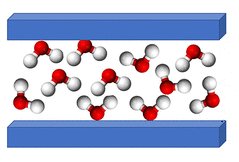Alessio Zaccone and Laurence Noirez, J. Phys. Chem. Lett.12 (2021) 1, 650–657.
Liquids confined to sub-millimeter scales have remained poorly understood. One of the most striking effects is the large elasticity revealed using good wetting conditions, which grows upon further decreasing the confinement length, L. These systems display a low-frequency shear modulus in the order of 1–103 Pa, contrary to our everyday experience of liquids as bodies with a zero low-frequency shear modulus.
While early experimental evidence of this effect was met with skepticism and abandoned, further experimental results and, most recently, a new atomistic theoretical framework have confirmed that liquids indeed possess a finite low-frequency shear modulus G′, which scales with the inverse cubic power of confinement length L. We show that this law is universal and valid for a wide range of materials (liquid water, glycerol, ionic liquids, non-entangled polymer liquids, isotropic liquids crystals). Open questions and potential applications in microfluidics mechanochemistry, energy, and other fields are highlighted.
https://doi.org/10.1021/acs.jpclett.0c02953.


